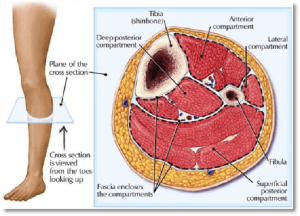As Townsville is a large fitness orientated city, plenty of runners, sports people, military personnel and gym enthusiasts may have come in contact with the condition known as compartment syndrome. Compartment syndrome, also referred to as chronic exertional compartment syndrome (CECS) is defined as increased pressure within a closed fibro-osseous space, causing reduced blood flow to nerves and muscles within that compartment. Which can lead to ischemic (decreased blood flow) pain and possibly permanent damage to the tissues of the compartment due to the lack of oxygenated blood. It may be acute, chronic (exertional), or convert from chronic to acute and visa versa.
Within the lower leg (knee to ankle), humans tend to have 4 – 5 compartments, which are separated by thin tendon-like tissues known as fascia. Within these compartments are muscles, nerves, arteries and veins. There is the anterior compartment, lateral compartment, deep posterior compartment and superficial posterior compartment. Some people have also been known to have an extra 5th compartment, which can be a predisposing factor to the condition.

CECS with stress fractures, and medial tibial stress syndrome (shin splints) are key components of differential diagnosis of leg pain in sportspeople, especially in distance runners and those sportspeople in aerobic training. The syndrome often affects both legs.
Acute compartment syndrome can develop from traumatic injury to the region either through fractures or broken bones, leading to bleeding into the compartments that results in gradually increased pressure. This usually presents with varying degrees of pain, redness of the skin, sensation of increased pressure and tightness of the muscles. CECS tends to be due to biomechanical cause or repetitive inappropriate loading of particular compartments. This can leave you with the feeling of increased pressure and aching pains upon exertion (eg. running) and may also have either sensation changes (pins and needles, weakness or numbness) of the foot due to compression of the nerves. This is often caused by poor foot, ankle, knee or hip biomechanics, in which a physiotherapist can help address.
There is numerous investigations available to aid in diagnosis of compartment syndrome, with one of the most useful tests being the intracompartmental pressure measurements. This involves placing a needle into the suspected compartment after exertion and getting a reading of how much pressure is in there. This as well as a clinical examination with a physiotherapist/ physician can lead to accurate diagnosis.
There are conservative and surgical treatments available depending on the nature of your condition. Physiotherapy management mainly consists of activity modification, soft tissue release techniques and addressing biomechanical issues that may be causing the syndrome (because without addressing these, the outcomes of future rehabilitation are pointless). Surgically they can release the fascia surrounding the compartment, and thus decrease the pressure within the compartment. Usually post-operatively there is an 8-12 week rehabilitation phase before being able to return to sport. Often surgery will not be considered until conservative management has been attempted.
So here are a few do’s and don’ts if you have been diagnosed with compartment syndrome or suspect you may have it:
Do’s –
- Seek assessment from doctor/ sports specialist, physiotherapists and podiatrist
- If suspect acute compartment syndrome, seek medical assessment as soon as possible
- If you’re a runner and your symptoms get worse by running, consider other means of cardio fitness such as biking and/or swimming. This is just to decrease the repetitive loads being put through the compartments
- Consider foam rolling pre and post exercise
Donts –
- Continue your current exercise program that is making your symptoms worse
- Push through pain when exercising


